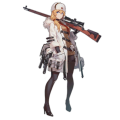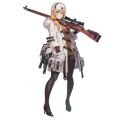Mosin-Nagant
| Mosin-Nagant | Story | Quotes | Live2D |
Mosin-Nagant39
    | |
| Gun Information | |
|---|---|
| Full name | Mosin–Nagant M1891/30 |
| Country of origin | Russian Empire |
| Manufacturer | Tula, Izhevsk, Sestroryetsk, Manufacture Nationale d'Armes de Châtellerault, Remington Arms Company, New England Westinghouse, many others |
| Game Information | |
| Faction | Griffin & Kryuger |
| Manufactured / Revised by |
I.O.P. |
| Voice actor | Uesaka Sumire |
| Artist | 防弹乳牛 |
| Released on | CN (莫辛-纳甘), TW (莫辛-納甘), KR (모신나강), EN, JP (モシン・ナガン) |
| Chibi Animation | |
| Variant:
Click the marked area to switch between animations. For details regarding animations, please see Animations on the Wiki. | |
Contents
How to obtain
NORMALHEAVY Timer 4:10:00. See T-Doll Production for details.
DROP 0-3, 4-6, 5-3E, 5-6, 6-5, 6-3E, 7-5, 7-1E, 8-1, 8-2E, 9-4, 9-1E, 10-2, 10-6, 11-3, 11-2E
REWARD Not obtained as a reward
Exclusive Equipment
Union Skill
There is no union skill for this T-Doll.
Stats / Data
Weapon Background
The Mosin-Nagant, known originally as the 3-Line Rifle Model of 1891, is a internal magazine-fed military bolt action chambering the legendary 7.62×54mmR cartridge. It served as the primary rifle for the armed forces of both the Imperial Russian Empire and the Soviet Union, and would see service in the armed forces of many other nations both inside and outside of Europe. It stands as one of the most widely-produced military bolt-action rifles in history, with somewhere around 37 million rifles being produced in the 130 years since its creation.
In 1877, the Imperial Russian military, armed with their single-shot Berdan rifles, would suffer a series of crushing and humiliating defeats at the hands of the Ottoman Empire, who made fantastic use of their Winchester repeating rifles. Despite the terrible performance of the Berdan rifle, it wouldn't really be until 1883 that the Russian military would begin to seriously seek out a new rifle. A commission was formed, with the primary goal of finding a magazine system for the Berdan rifles already in service. The commission's secondary goal, in the event that they were unable to achieve their main task, was to find a new rifle to replace the Berdan.
In 1886, the French would introduce the Lebel rifle and its revolutionary smokeless powder cartridges. Suddenly, a lot of the work the Russian rifle commission had been doing to upgrade the Berdan (and its large-bore, black powder cartridges) was rendered obsolete. Work soon began on developing a new smokeless powder cartridge, and a new rifle capable of chambering it. By 1889, development was finished on a new smaller-bore smokeless powder cartridge, the 7.62×54mm rimmed cartridge. Now all that remained was figuring out a rifle to go with it.
In 1890, the commission would hold a series of rifle trials. Three designs were submitted for evaluation: one by Belgian designer Léon Nagant, another by Russian captain Zinoviev, and a third rifle submitted by Captain Sergei Ivanovich Mosin (Mosin had actually been working on his rifle with the commission since at least 1884). Two versions of the Mosin rifle were present at these trials: a single-shot version without a magazine, and a version sporting a modified version of Nagant's magazine system. The evaluators at the trials stated that Nagant's rifle had an advantage over the other designs, and listed several issues with the magazine on the Mosin designed rifle. This was a little bit unfair to Mosin, because he had been aware of the issues and had actually devised improvements to fix them, but wasn't allowed to stop production and have the changes implemented on the rifles being sent to the trials. Meanwhile, Nagant had been allowed by the commission to submit only a third of the desired rifles for testing (the commission had wanted 300 test rifles from each applicant).
Mosin would have an opportunity to demonstrate the improvements to his design in March of 1891, where his rifle performed much better. Later that month, another set of tests would be conducted between the improved Mosin rifle and the Nagant designed rifle. These tests were conducted by a panel of 24 judges, who gave their opinions on both designs. Even with the improvements Mosin had made, the panel voted in favor of the Nagant rifle. However, it would be the Mosin rifle that would end up getting adopted, and this decision mainly came down to economics. As a result of being designed domestically, the Russian arsenal system already knew how to produce Mosin's rifle. In addition, Mosin's design was a lot more forgiving in terms of dimensions, which made mass-manufacturing of the rifle a lot easier. By contrast, Nagant's rifle was much more of a precision affair, so much so that even Nagant himself hadn't been able to make enough of them fast enough for the 1890 trials. And so, Mosin's rifle would be officially adopted by the Imperial Russian Military as the 3-Line Rifle Model 1891 (a 'line' in this case refers to an old Imperial Russian form of measurement, with a single 'line' being roughly equivalent to about 2 and a half millimetres. 3 'lines' would equal out to around 7.62 mm, which matched the caliber of the rifle).
Despite bearing the names of both Sergei Mosin and Léon Nagant, Nagant's contributions to the final design were relatively minor, mostly centered around the magazine and interrupter. However, in the contract made between Nagant and the Russian Government, Léon would get around 200,000 Rubles if his rifle design was adopted. No stipulations had been made for what would happen if only part of his design was used. Léon had stated that they would be happy with 75,000 Rubles for their work, while the Russian government was split between whether to give Nagant only 50,000 Rubles or not pay the man at all. Nagant would get the upper hand in these negotiations, though, because the Russian government had made a deal with French arms manufacturer Châtellerault to produce 500,000 Mosin-Nagant rifles to help quickly rearm their massive army within a reasonable timeframe. Nagant had gone ahead and patented certain bits of the magazine system in France, which meant that if the Russian government failed to properly pay Nagant, they could be sued in French court. Nagant ended up getting the full 200,000 rubles his contract stated despite only being responsible for a small part of the final product. Léon Nagant would doing business with Russia again in 1895, producing his famous M1895 revolver.
The M1891 rifles would first see real action during the Andijan Uprising in 1898, followed soon after by the Russo-Japanese War in 1905. The first major changes to the rifle would be based on its performance in these conflicts. The Mosin-Nagant design would see a number of updates and alterations made to it by the various countries that used it. In particular, the modifications made by the Finnish army would see the Finnish variants of the Mosin be listed as some of the highest quality Mosin variants. However, the Russian M91/30 is by far the most common of all the Mosin models. A modified version of the original M1891, the M91/30 would see service during the Second World War as the primary infantry rifle of the Soviet Army. Following the conclusion of World War 2, the Mosin-Nagant would be replaced for more modern rifles such as the SKS and the AK-47. Many of these rifles would be sold to Communist nations around the world, and would see use in the Korean War, the Vietnam War, and many other conflicts. Many are still found in use by rebels and insurgents in areas such as Ukraine and the Middle East.
With 37 million rifles produced, the Mosin-Nagant is a very common (and inexpensive) collector's rifle, with many still available on the surplus market. Its availability and low price also makes it a common gun to see in the hands of hunters and casual shooters, especially the shorter carbine versions. Because of this, a large aftermarket has sprung up around the Mosin platform, offering various parts and conversion kits.
Character Design
She has long blonde hair and blue eyes. She wears an all-white uniform with a trimmed shawl, a white ushanka with a Soviet army badge, and a pair of white gloves. She is dressed for winter operations, and the white clothes are to conceal her presence from enemies, with the exception of her black stockings and a pair of brown boots. She has a petrol bomb (Molotov Cocktail) strapped to her right thigh. She is shown wearing a black bra in her damaged art.
If the 'Luna Sea' Skin is used, she has a crown braid on her hair with a white lily hair ornament, a blue ballroom dress, and a pair of black stockings.
Upon receiving her neural upgrade, her uniform greatly changes. She still sports her ushanka, but she now wears a white jacket, a beige sweater top with a red tie, black pantyhose, and a pair of high heels. She is also now equipped with RPG-43 anti-tank hand grenades instead of the former petrol bomb. When damaged, she brandishes a survival entrenching tool.
Gallery
Main artwork
Gallery consisting of artworks used primarily in-game. For information on how to obtain certain costumes, see Skin Catalogue.
Alternative artwork
Alternate gallery consisting of artworks with slight alterations as well as miscellaneous artworks.
Trivia
- The default skin features an "ex-sniper" M91/30, whereas the Luna Sea skin features a scoped PU M91/30. These rifles were handpicked for use by snipers, and had an angled bolt handle to accommodate for the added optic.
- Simo Häyhä, a Finnish sniper who came to be known as the 'White Death', scored the highest confirmed sniper kill count in history with 505 kills to his name using a Finnish manufactured Mosin variant, the M/28-30. Unlike other snipers, Häyhä preferred iron sights over using an optic, as sunlight would reflect off the glass of the scope and give away his position.
- During World War I and the Russian Civil War, there was a demand for smaller, easily-concealed firearms. To meet this demand, Russian troops and partisans would shorten Mosin rifles, cutting down the stock and barrel. This configuration would be dubbed the "Obrez".
- In order to prevent the parts from freezing, sometimes Soviet Infantry mixed gun oil and gasoline to lubricate the component of the gun.[1]
- The Dyakonov Grenade Launcher is an interesting attachment for the Mosin Rifle produced in 1942. Rather using a blank round to ignite a primer, it can be launched by a live round as the primer itself has a hollow for the live rounds to exit from. The Dyakonov Grenade Launcher Attachment for the Mosin was still used after WWII.
- During the April Fool's update, MICA Team gave Mosin-Nagant an update where she rode a horse in her in-game sprite. This is NOT A PERMANENT CHANGE and will usually revert back to normal in a later update.
- This happened during the Russian Civil War, where horses was used extensively in cavalry divisions by both sides (also called dragoons). Even after Mechanized Corps entered widespread service in World War II, horse cavalry was still used in limited cases to flank, harass and break through enemy lines.
- Ethnic Cossack traditions are steeped in extensive familiarity and use of horses. With the outbreak of war, this proficiency with equestrian skills lended itself to easy adaptation to a competent cavalry force.
- During World War II, many Soviet sharpshooters utilized explosive-filled 7.62x54 PZ bullets which were designed for use with aircraft armaments. The usage of these rounds against infantry units is prohibited by Geneva Convention rules.
- PZ bullets were responsible for destroying half of Simo Häyhä's left cheek.
- The Mosin-Nagant has very mixed reviews among the gun community (especially the models from WW2), mostly due to its "random quality". One Mosin rifle couldn't hit a target at around 200 meters, while the other Mosin rifle can hit the target that's 800 meters away with ease.
- This is mostly due to the manufacturer and the time it was produced. Say you have a Mosin-Nagant that was produced by Izhevsk during World War 2. That rifle would have a 50/50 chance of being good or being bad. Meanwhile, the Mosin-Nagants that were produced by Remingtion Or Izhevsk during the pre-war years are usually better in terms of quality than the ones produced in war time .This also extends to the Finnish manufacturers like SAKO, who made excellent Mosin rifles during World War 2.
- Another reason for the Mosin's reputation of inconsistent accuracy is that Mosin-Nagants had their sights zeroed with the bayonet affixed, as Russian combat doctrine at the time mandated that the bayonet remain attached to the rifle at all times. As a result, the sights on a Mosin rifle may be off to one side.
References
| List of T-Dolls |
|---|




















